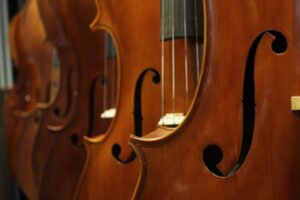
The violin and viola present two outlets of musical expression often seen as similar, but I find that each instrument has its own unique quality and beauty. Starting my musical journey on violin, I felt like I joined a wrestling match against violists as my violinist peers threw around a plethora of viola jokes and maintained a friendly distance. I soon learned that the ongoing jovial tension overlooked the importance each instrument brings to the table. I also began playing viola in addition to violin while in highschool and have fallen in love with the viola sound even more. Violins would not have existed if it had not been for the viola.
You might be wondering how to differentiate between the sounds when listening to a symphony orchestra or deciding which instrument is best for your child to learn and these points provide key hints for making the distinction and finding whether your child should begin Atlanta violin lessons.
The Shape
One telling factor is that the viola has a bigger shape than the violin. A full size viola ranges between 15 to 18 inches in length while a full size violin is about 14 inches. The lower half of a violin has a slimmer shape as well but the viola is generally wider. Due to the bigger size, some children start on violin then switch to viola as they get older and taller, but violas can be customized to different sizes, seeing that 12 inch violas exist.
The Sound
If the sound of the violin is like a soprano, then the viola is like an alto. The strings of a violin are higher and the viola has lower strings like the cello, carrying a rich and mellow sound. Due to the difference in strings, violinists can play higher and violists can play up to four steps lower than a violin. Viola then stands between the sound of a violin and cello
The Clef
The sheet music for viola and violin provide a clear differentiation between each instrument. At the beginning of each staff line, you will see different clefs. Violinists read in treble clef while violists read notes mostly in alto clef as shown on the left. A cool aspect of playing viola is the knowledge of reading treble, alto, and bass clef because of the viola’s range.
The Demand
The performance and career market calls for different and necessary demands for violinists and violists. Since violinists make up two major sections of an orchestra, auditions for these sections are generally available. The violin sound has also been used in a variety of different spaces beyond classical music for jazz, rock, and other genres, making the opportunities endless for violinists. Still, finding solid viola players is also a huge demand. Despite the popularity of other instruments, viola adds an important depth to sound, for both solo and harmonic contexts. I began playing viola because my local chamber program was in desperate need of violists and I continued playing because the need was present in every music space I encountered. For wedding gigs, chamber groups, recordings, you name it – many people are looking for a great viola player.
Violin Or Viola?
Now, violin or viola? The choice is yours, and Lessons In Your Home provides you opportunities to explore both instruments with our teachers and resources. Trust me, there is room for any curious beginner regardless of instrument choice!
If you are interested in learning more about the violin or if you want to sign up for lessons, contact us! Our teachers come right to your home for every lesson, plus we offer virtual music lessons, too. Our online music lessons are taught by local music teachers with live lessons tailored to your family!
